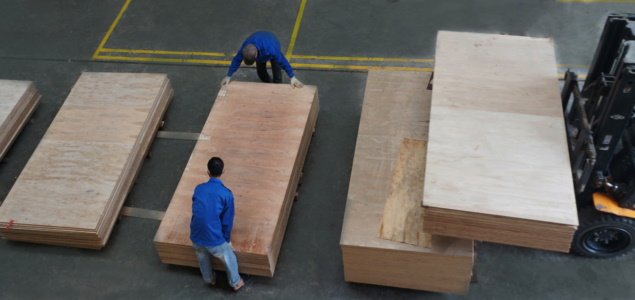Furniture export orders are starting to return from the end of the second quarter of 2023, although they have not yet recovered strongly. Vietnam’s main market is the US, which has begun to import wood products, Australia, South Korea, and India are also developing stably and there is a need to import more furniture products…
According to the Department of Forestry (Ministry of Agriculture and Rural Development), the export value of forest products in the first 6 months of 2023 of Vietnam is estimated at 6.42 billion USD, down nearly 29% compared to the same period in 2022. Still optimistic that it can reach the export milestone of 14 billion USD by the end of the year when businesses begin to receive some new orders.
GEOGRAPHY DEVELOPMENT IN THE NEXT 5 YEARS
The woodworking and furniture industry in the first months of 2023 received negative numbers, although it has been forecasted from the end of 2022, the lack of orders caused factories to reduce capacity, reduce labor even more. wave of land clearing, factory…
Preliminary survey results with businesses conducted by the Handicraft and Woodworking Association of Ho Chi Minh City (HAWA) show that, in the first 6 months of 2023, orders at enterprises in the industry decreased by an average of 30%. However, in July 2023, businesses in the industry began to receive orders again, serving the year-end furniture shopping season of the world market.
This is good news for Vietnam’s wood industry, shared by Mr. Nguyen Quoc Khanh, Chairman of HAWA at “Vietnam Furniture and Wood Industry Forum”, on the afternoon of July 28, 2023.
Given that the current difficulty in reducing orders of the wood industry is only temporary, economist Pham Phu Ngoc Trai said that the Vietnamese furniture industry has enough room to develop in the next 5 to 10 years.
“Compared to the average global GDP development, at 3%, the compound growth rate of the world furniture industry is 4.5%, Vietnam’s wood processing industry grows at an average of 15.4%/year. five is a number that proves its position and great potential,” said Mr. Trai.
Ms. Tran Nhu Trang, representative of SIPPO Vietnam program, shared in detail about the recovery of the top 5 wood export markets of Vietnam such as the US, Europe, Japan and many other countries. Fortunately, there are not only positive signals on output growth, but also many new trends and requirements from these markets.
Vietnam’s wood export market is also facing opportunities to supply products to some Middle Eastern countries. This signal marks an important turning point for Vietnam’s furniture industry, creating an opportunity for this industry to fulfill its export target.
MEET THE NEW STANDARD
The recovery of markets in Japan, Korea, India, Canada and many other countries, as consumers began to return to shopping stores after a long time affected by the pandemic. However, it is worth noting that these markets also place high demands on Netzero’s commitment to carbon reduction. This requires Vietnam’s wood industry to focus on using sustainable raw materials and production processes, helping to reduce carbon emissions into the environment.
In the European market, it is also shaping the consumption trend of the wood furniture industry when accounting for two-thirds of the market share of high-end products imported from Vietnam. This poses many requirements for sustainable consumption, requiring Vietnam’s wood industry to improve and adapt to international standards on environment, society and corporate responsibility.
To achieve sustainability goals and meet increasingly stringent requirements from the market, the Vietnamese wood industry needs to define a new strategy.
Firstly, it is necessary to improve the quality and added value of products to increase competitiveness and attract the attention of fastidious markets.
Second, it is necessary to invest in research and development, to offer products with creative and unique designs that adapt to the diverse tastes of consumers.
Repositioning the development vision for Vietnam’s furniture industry in the new context, Ms. Pham Thi Ngoc Thuy, Director of Board IV, said that new market challenges related to European Union wood standards ( European Union Timber Regulation – EUTR) or Net Zero goal will also help Vietnam’s wood processing and forest products industry develop in a more positive direction. Since then, creating conditions for the industry to reach out further, attracting more investment flows from foreign investors.
According to Mr. Nguyen Chanh Phuong, Secretary General of HAWA, in terms of sustainable development, it is a challenge but also a new opportunity for businesses. It is possible that by 2028, the wood industry will really face the problem of reducing emissions.
“Currently, we and the Ministry of Agriculture and Rural Development are communicating for businesses to take a step to prepare for emission reduction. The government is also formulating policies. I think taking advantage of this opportunity is very important in building a sustainable wood furniture industry,” emphasized Mr. Phuong.
Promoting the export of wood furniture also requires close cooperation between businesses and authorities, ensuring compliance with export regulations and standards of each market. Improving operational and quality management capacity is also an important factor to maintain reputation and meet high quality requirements of demanding markets.
It is necessary to promote marketing and promotion of Vietnamese wood furniture brands in the world. Using modern communication channels and digital technology will help reach a large number of potential customers and create a reliable, high-quality image for the Vietnamese wood industry.
In addition, establishing reliable partnerships with international companies, distributors and agents will also help to expand the market and access more orders.
In particular, it is necessary to strengthen exchanges and cooperation with businesses in the wood industry of countries with a large tradition of wood production and consumption, in order to learn and share experiences, and create favorable conditions for the opening of timber. expand markets and strengthen global competitiveness.





